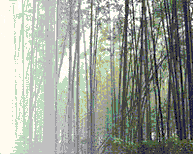

|
|

Fibers and yarns made from bamboo

Bamboo
Introduction
Bamboo fiber and starchy pulp are made
from bamboo that grows widely throughout Asian countries. Starchy pulp is a
refined product of bamboo stems and leaves through a process of hydrolysis-alkalization
and multi-phase bleaching. Chemical fiber factories then process it into
bamboo fiber.
Many Asian countries overall development policy is to make limited use of natural
resources, concentrating on the renewable ones. This policy recognizes the
importance of rural activities, such as agriculture, forestry and handicrafts
production. Bamboo is involved
in all of these. The demand for bamboo is bound to increase over
time, particularly for use as fodder and other multipurpose uses. There is ample
scope for greater bamboo production, especially in the higher areas
where communities are widely dispersed and agriculture is less profitable.
The manufacture of handicrafts using locally-available materials, such as
bamboo, and employing simple techniques and equipment is now emphasized in many
countries. It is fortunate in having highly-skilled craftsmen, a strong
cultural heritage, and a good supply of renewable resources. There is a need,
however, for improving the design of handicrafts and hence their market appeal.
This could raise the income of the rural people while allowing them to maintain
their culture and way of life.
Increasing the use of bamboo resources in the making of Asian handicrafts
has the advantage of building upon existing traditions without threatening the cultural heritage or way of life.
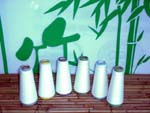
Properties
Repeated technological analysis has proved that this kind
of fiber has a thinness degree and whiteness degree close to normal
finely bleached viscose and has a strong durability, stability and
tenacity.
It stands abrasion and possesses a perfect quality to spin.
The yarn and
cloth made by this kind of fiber are labeled first-class quality in all
aspects of quality standards.
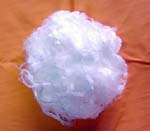
Bamboo fiber
fabric is made of 100% bamboo pulp fiber. It is characterized by its
good hygroscopility, excellent permeability, soft feel, easiness to
straighten and dye and splendid color effect of pigmentation. It is also
a new environment-friendly raw material that enjoys a splendid prospect
for application as its predecessor wood pulp fiber. Meanwhile cloth made by the
mixed texture of bamboo fiber and cotton or other raw materials also
boasts the same superior property.
Towel and bathrobe made of bamboo fiber have a soft and comfortable
feel and a special luster. When dyed, it is sparkling and beautiful. It
is also highly absorptive to water. Bacteria are hard to breed on the
foot mat and mat.
| Applications
The fashion world is constantly seeking and latching onto new materials. The
folk fashion craze spurred demand for natural, handmade-looking textiles that
exude warmth, while synthetic fabrics with a sleek look have also recently been
popular. One of the hot item is fabrics made from traditional Japanese
materials, such as bamboo and washi (handmade Japanese paper).
A spotlight grabber at the Tokyo Spring and Summer collection was a series of coats and pants made of fabric containing bamboo
fibers. Bamboo fiber clothes have actually
been showing up in department stores and women's boutiques. An exclusive
manufacturing process makes it possible to create a highly breathable, absorbent
fabric entirely from bamboo fiber. Clothes made of this fabric sell for around
the same price as ordinary clothes and have a
distinctive softness and cool, light texture.
An interesting information was recently obtained
from the market that 100% bamboo yarns show a great elasticity (nearly 20%) in the yarn. Even in woven fabrics a
remarkable elasticity can be obtained. Our supplier partner even thinks that in 100% bamboo fabrics there is no need of elasthanes.
Another positive point besides the already known ones is that bamboo fabrics need less dyestuffs than cotton, modal or viscose. It seems that the absorption of dyestuffs is remarkably better. Bamboo absorbs the dye stuffs faster and shows the colors better.
Bamboo is considered as a much superior fiber and playing in a category of its own. In softness it even beats Tencel.
Our supplier partner in Turkey has been successfully spinning a Ne 60/1. Upon
special order we are also able to supply it in S + Z spin
twist for Santoni seamless knitting.
The fabric is highly versatile;
other garments, such as blouses and tank tops, are also available.
- bathrobes and towels
- foot mats
- mats
- bed clothes
- underwear
- close-fitting
T-shirt
- stockings
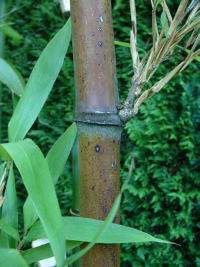
Current and Potential Uses
A few of its major uses,
identified with the general most commonly used for each product, are listed
below:
Bambusa
species
∑ split and woven mats
∑ used whole for construction and scaffolding
Dendrocalamus
species
∑ roofs and walls of houses
∑ domestic and agricultural implements, such as
water containers,
baskets, trays, mats, etc.
∑ leaves provide valuable fodder for livestock
∑ shoots are edible and can be preserved
Drepanostachyum
species
∑ finely woven domestic and agricultural
equipment, such as baskets,
trays, mats, sieves, etc.
∑ livestock shelters and temporary dwellings
∑ parts of traditional houses
∑ edible shoots
Thamnocalamus
species
∑ roofing, mats and fencing
Arundinaria
species
∑ high-quality woven handicraft products, such as
food and drink
containers, hats, arrows, quivers, etc.
∑ winter and dry season livestock fodder
∑ durable mats for building construction
fencing material
∑ edible shoots
∑ shelter and food for endemic fauna in reserve
areas
.
|
Grades
- flat yarn
- fibers
- tow/tops
- spun yarns
|
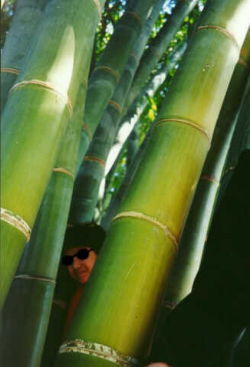
|
| Processability
The merits of bamboo for use in textile fibers are their
breatheability (ideal for humid summers), the ease of processing them
into fabric, their high functionality, and their beauty. The fashion world's
fascination with all things Oriental and Japanese continues unabated,
and bamboo is attracting the interest of a growing number of designers. More
and more of this material is expected to find its way onto store shelves as
time goes by.
Bamboo fibers and yarns can be treated
in the same way as you would treat viscose rayon fibers and
yarns.
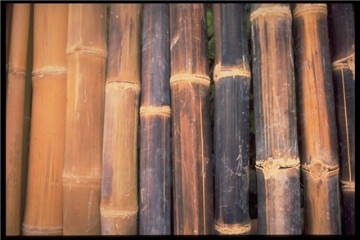
|
| Background
information
Interesting facts about
bamboo - Bamboo is:
- The fastest growing woody plant on this planet. It grows one third faster than the fastest growing tree. Some species can grow up to 1 meter per day. One can almost "watch it grow". This growth pattern makes it easily accessible in a minimal amount of time. Size ranges from miniatures to towering culms of 60 meters.
- A critical element in the balance of oxygen / carbon dioxide in the atmosphere. Bamboo is the fastest growing canopy for the
re-greening of degraded areas and generates more oxygen than equivalent stand of trees. It lowers light intensity and protects against ultraviolet rays and is an atmospheric and soil purifier.
- A viable replacement for wood. Bamboo is one of the strongest building materials. Bamboo's tensile strength is 28,000 per square inch versus 23,000 for steel. In the tropics is it possible to plant and grow your own bamboo home. In a plot 20m x
20m, in the course of 5 years, two 8m x 8m homes can be constructed from the harvest. Every year after that the yield is one additional house per plot.
- An enduring natural resource. Bamboo can be selectively harvested annually. Bamboo provided the first re-greening in Hiroshima after the atomic blast in 1945. Thomas Edison successfully used a carbonized bamboo filament in his first experiment with the light bulb.
- Versatile with a short growth cycle. There are over 1000 species of bamboo on the earth. The diversity makes bamboo adaptable to many environments. It can be harvested in 3-5 years versus 10-20 years for most softwoods. Bamboo tolerates extremes of precipitation, from 30-250 inches of annual rainfall.
- A critical element of the economy. Bamboo and its related industries already provide income, food and housing to over 2.2 billion people worldwide. There is a 3-5 year return on investment for a new bamboo plantation versus 8-10 years for rattan. Governments such as India, China and Burma with 19,800,000 hectares of bamboo reserves collectively, have begun to focus attention on the economic factors of bamboo production.
- An essential structural material in earthquake architecture. In Limon, Costa Rica, only the bamboo houses from the National Bamboo Project stood after their violent earthquake in 1992. Flexible and lightweight bamboo enables structures to
"dance" in earthquakes.
- A renewable resource for
agro forestry products. Bamboo is a high-yield renewable natural resource: ply bamboo is now being used for wall paneling, floor tiles; bamboo pulp, for paper making, briquettes for fuel, raw material for housing construction, and rebar for reinforced concrete beams.
- A soil conservation tool. Bamboo is exquisite component of landscape design. It's anti-erosion properties create an effective watershed, stitching the soil together along fragile river banks, deforested areas, and in places prone to earthquakes and mud slides. The sum of stem flow rate and canopy intercept of bamboo is 25% which means that bamboo greatly reduces rain run-off, preventing massive soil erosion.
- An ancient medicine. Bamboo has for centuries been used in Ayurveda and Chinese acupuncture. The powdered hardened secretion from bamboo is used internally to treat asthma, coughs and can be used a an aphrodisiac. In China, ingredients from the root of the black bamboo help treat kidney disease. Roots and leaves have also been used to treat venereal disease and cancer. Sap is said to reduce fever and ash will cure prickly heat. Current research point to bamboo's potential in a number of medicinal uses.
- Integrally involved in culture and the arts. Bamboo is a mystical plant as a symbol of strength, flexibility, tenacity, endurance,
luck and compromise. Throughout Asia, bamboo has for centuries been integral to religions ceremonies, art, music and daily life. It is the paper, the brush and the inspiration of poems and paintings. Among the earliest historical records, 2nd century B.C. were written on green bamboo strips strung together in a bundle with silk thread. Instruments made of bamboo create unique resonance.
- A food source: Bamboo shoots provide nutrition for million of people worldwide. In Japan, the antioxidant properties of pulverized bamboo bark prevents bacterial growth and its used a natural food preservative. Bamboo
make fodder for animals and food for fish. Taiwan alone consumes 80,000 tons of bamboo shoots annually constituting at $50 million industry.
- A landscape design element. Bamboo is an exquisite component of landscape design. For the human environment, bamboo provides shade, wind break, acoustical barriers and aesthetic beauty.
A very brief Bamboo Glossary
- Auricle: an ear-like appendage that occurs at the base of some leaves.
- Cilium (pl. Cilia): one of the marginal hairs bordering the auricle.
- Caepitose: growing in tufts, or close clumps, as in bamboos with sympodial rhizomes.
- Clone: all the plants reproduced, vegetatively, from a single parent. In theory, all the plants from the same clone have the same genotype (genetic inheritance).
- Culm: the main stem of the Graminae (grasses). The stem of a bamboo is also referred as a cane.
- Culm Sheath: the plant casing (similar to a leaf) that protects the young bamboo shoot during growth, attached at each node of culm. Useful for distinguish species within a genus.
- Cultivar: seedling sports from a species which have multiplied from a single clonal source. A sport is a plant abnormally departing, especially in form or color, from the parent stock; a spontaneous mutation.
- Gregarious flowering: usually occurs when all plants in a single clone (which has been repeatedly divided and distributed) flower at about the same time.
- Gutation: water expelled over night as droplets from the tips of bamboo leaves.
- Internode: segment of culm, branch, or rhizome between nodes.
- Leptomorphic: temperate, running bamboo rhizome. Itís usually thinner then the culms they support and the internodes are long and
hollow.
- Monopodial: describes the growth habit of the rhizomes of running temperate bamboos. The main rhizome continues to grow underground, with some buds producing side shoots (new rhizomes) and others producing aerial shoots (new culms).
- Node: the joint between hollow segments of a culm, branch, or rhizome; the point at which a rigid membrane of vascular bundles lends strength to an axis of bamboo by crossing it from wall to wall.
- Pachymorphic: describes the rhizomes of clumping bamboos. They are short and usually thicker then the culms they produce. These rhizomes have a circular cross-section that diminishes towards the tips. The internodes are short, thick (except the bud-bearing internodes, which are more elongated) and solid (with no cavities). See also
Sympodial.
- Rhizome: a food-storing branch of the underground system of growth in bamboos from buds of which culms emerge above ground. Popularly known as rootstock, rhizomes are basically of two forms: sympodial (tropical, clumping, Pachimorph) and monopodial (temperate, running,
Leptomorph).
- Rhizome sheathe: husk-like protective organ attached basally to each rhizome node.
- Running: describes a bamboo whose rhizomes have a markedly horizontal growth habit, and tend to develop along the surface of the soil.
- Shoot: the stage in the development of the bud before it becomes a culm with branches and leaves.
- Sulcus: a groove or depression running along the internodes of culms or branches.
- Sympodial: describes the growth habit of the rhizomes of caespitose bamboos. The rhizomes emerge from the lateral buds of other rhizomes, while the terminal buds produce new culms. See also
Pachymorphic.
- Turion: the tender young shoot as it emerges from the ground without branches or leaves.
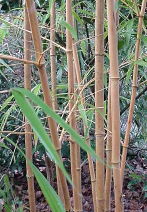
More than 200 species of bamboo are
recognized, varying in size from a few feet to more than 100 in height. The
tender, young shoot growth of many of these species is used as food, in the
United States mainly in Chinese dishes. Sprouts harvested in the United States
are limited to Hawaii and Puerto Rico, but substantial quantities are imported.
Since new sprout growth quickly becomes hard and woody, the maximum period of
exposure of edible parts to direct pesticide application would be approximately
a month.
|
Bamboo Identification
There is now a laboratory recommendation
on how to determine that bamboo yarns and fibers are really made from
bamboo and not from simple viscose. For more details you may contact us.
There are different types of bamboo fibers:
|
name
|
description
|
spinning process
|
properties
|
|
|
|
|
|
|
|
|
|
|
|
Bio-bamboo
|
regenerated bamboo)
|
Lyocell spinning
|
soft, fine, higher wet strength, green product
|
|


![]()

